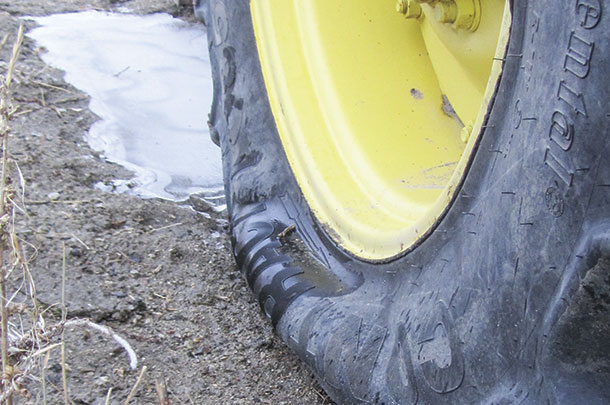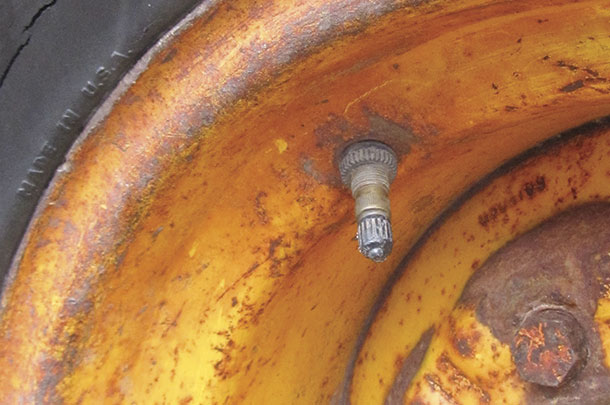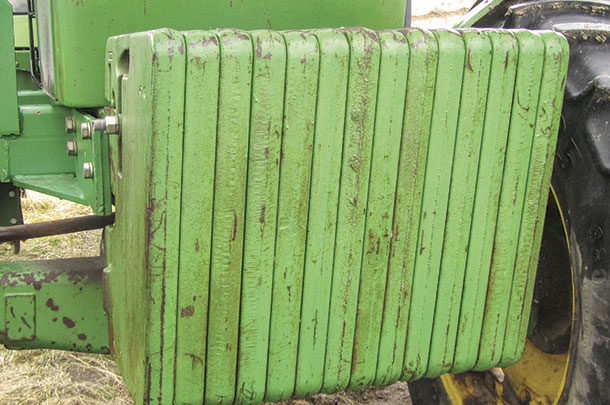Since the first small two-wheel-drive tractors were introduced here in the rugged mountain country of central Idaho, we have worked to enhance the traction and lower the center of gravity of our farm and ranch tractors.For three generations, my family has loaded these tires with calcium chloride (CaCl2) and water to improve traction when pulling farm implements, reduce the risk of rollovers in steep country and increase stability when moving feed to cattle in the winter.
This mixture performed well to achieve these objectives – weighing approximately 11.5 pounds per gallon with a freezing point of minus 50ºF. But the highly corrosive quality of calcium chloride has caused much grief with rusted wheel rims, valve stems and other metal surfaces.
For several years, I fought frequent flat tires on a JD 4455 four-wheel-drive tractor I use to put up hay in the summer and feed cattle in the winter. This tractor came with radial tires, and the previous owner had installed tubes and loaded the tires with calcium chloride and water.
I discovered the support ridges on the inner side of the radial tires were wearing pinholes in the tubes, allowing the fluid and air to escape.

To solve my immediate problem, I evacuated the calcium chloride from the tires and removed the tubes. I soon discovered the tractor was not as sure-footed handling large hay bales on frozen ground.
External iron weights
Recently, I discovered I am not alone in this dilemma. Ed Snook, owner of Snook Ranch located near Tendoy, Idaho, bought a new mid-size, four-wheel-drive tractor last year to put up and handle hay for his operation. He enjoyed all of the power and features of the new tractor – until the afternoon he tipped the tractor on its side loading manure into a truck in the corral.
Clay Snook, who provides most of the mechanical assistance to Snook Ranch, says, “The tractor was too top-heavy, and the rear wheels were set too narrow. We couldn’t bring ourselves to put salt water in the wheels on a brand-new tractor, so we looked around and ended up mounting external weights to the rear wheels. That’s made a very positive difference.”
Because the attached 890 Allied front-end loader on my JD 4455 is the largest loader on the ranch, the tractor gets used for everything. Many of the areas where we carry large hay bales are not level, and some of the operators are not experienced enough to anticipate the risk of rollover in time to prevent it.
Due to the additional weight already added to the tractor frame, axles and bearings by the loader and front-end suitcase weights currently in place, I was hesitant to add external wheel weights and began looking for a way to return to liquid ballast.
Calcium chloride
Gregory Eppich, owner of Eppich Farms near Saskatchewan, Canada, says, “Calcium chloride is still the go-to for many farmers here because it is readily available and seems cheaper at the outset. After buying four new wheel rims recently, I’m not so sure.”
When I mentioned I had heard claims you can run calcium chloride in tubeless tires, Eppich says, “Some of the farmers are running radials tubeless with calcium chloride. The corrosion is minimized by keeping the tire loaded above the top of the rim – reducing the rim’s exposure to oxygen.

This may be effective for a while with a new tractor but, remember, every time you break the tire down to repair a puncture or replace a tire, you expose the rim to oxygen, and the more ballast you add, the more trouble you will have with power hop. Loading radial tires stiffens the sidewall and reduces the footprint of the tire – essentially turning a radial tire into a bias-ply tire.”
Bias-ply tires are still readily available, and many farmers and ranchers using calcium chloride are still running the bias-ply tires with tubes. Having spent over $2,000 for two new radial tires for this tractor over the past two years, and really not interested in returning to the corrosive properties of calcium chloride, I looked for other options.
Antifreeze (ethylene glycol)
When mixed at the same 50-50 ratio you would put in the radiator of your vehicles, the mixture has a freeze point of minus 40ºF and adds approximately the same amount of ballast as plain water, or roughly 8 pounds per gallon. Antifreeze is readily available and easy to mix and handle. Antifreeze is non-corrosive and can be run in tubeless tires without the risk of destroying rims.
Eppich says, “The most serious downside of ethylene glycol is the risk to the environment in the event of a puncture or spill. Animals are attracted to antifreeze, and it is very toxic to pets or livestock.”
Windshield washer fluid
Windshield washer fluid has a freeze point of minus 20 to minus 30ºF and a weight similar to water. The active ingredient in windshield washer fluid is methyl alcohol. While windshield washer fluid is readily available, methyl alcohol is extremely toxic and flammable.
Eppich says, “Besides the danger to the environment, washer fluid is a very expensive way to go. Also, we need to operate our chore tractors at temps below minus 30ºC in the winter to feed stock. Washer fluid would be solid much of the winter here.”
Eppich cautioned against blending raw methanol (methyl alcohol) and water. “Raw methanol is extremely toxic and flammable. For your own safety, I would discourage the use of methanol.”
RV antifreeze (propylene glycol)
Mixed 50-50, RV antifreeze has a freeze point of approximately minus 40ºF and similar weight per gallon to that of water. It can be loaded tubeless, as it is noncorrosive and nontoxic.
Eppich says, “RV antifreeze is a much safer choice than conventional antifreeze, and it is readily available in large quantities, but it is more expensive than conventional antifreeze.”
Bio-friendly liquid ballasts
Over the past 20 years, there has been an incorporation of crop byproducts in the creation of liquid ballasts that are biodegradable, noncorrosive and nontoxic. These products utilize such organic materials as sugar beets, soybeans and distillers byproducts. The sugar beet-based product weighs approximately 30 percent more than water and solidifies at approximately minus 50ºF.
Preston Gwinn, tractor owner near Bloomington, Indiana, says, “I have a four-wheel-drive Kubota with a front-end loader I use to do various things. I was having trouble with the back end coming off of the ground when I lifted anything heavy.
I spent a lot of time calling tire guys all over Indiana to find out what I could do to add weight to the back end of the tractor without putting anything corrosive or toxic in the tires. I discovered a sugar beet-based product made by Rim Guard. Since I had the ballast loaded into the rear tires of this tractor, I have not had to lock in the front end to do many of the chores that previously required four-wheel drive.”
Eppich adds, “There are many more options available today than in years past. You may have to make a few calls or prowl the internet, but you should be able to find the ballast that best suits your situation.” ![]()
PHOTO 1: External iron weights have been added to this John Deere 4455.
PHOTO 2: A calcium chloride and water solution leaks from a punctured tire on a John Deere 4455.
PHOTO 3: Corrosion to the outside of a rim and valve stem area is caused by exposure to calcium chloride. Photos by Michael Thomas.
Michael J. Thomas is a freelance writer. Email Michael J. Thomas.











